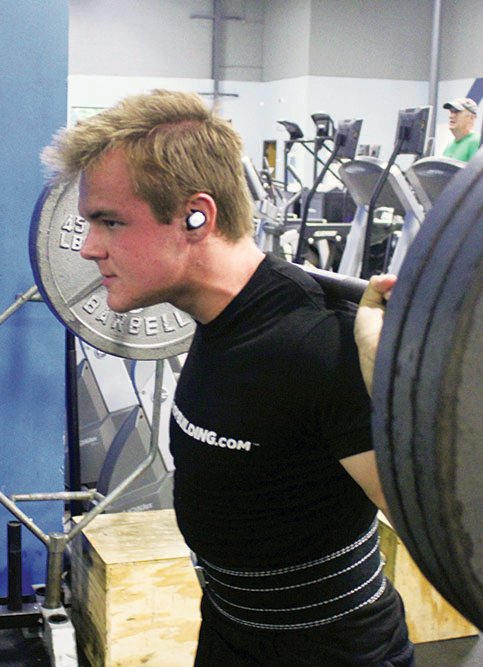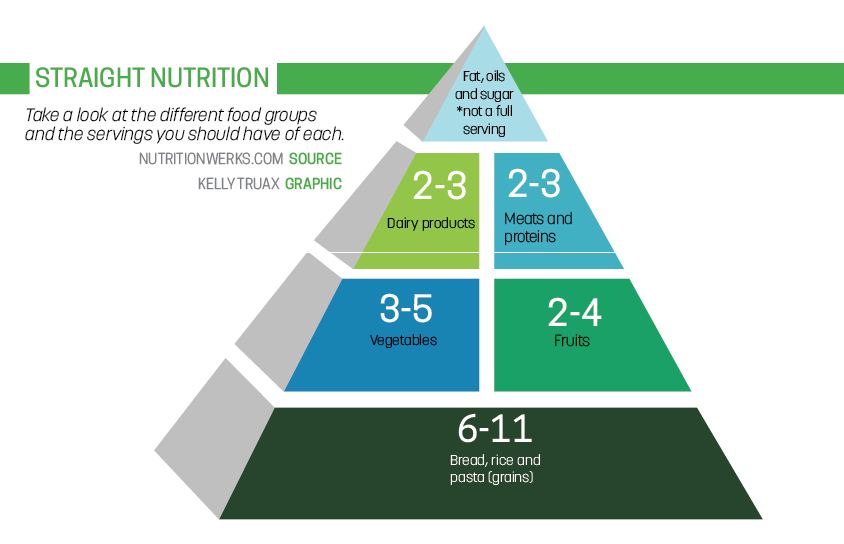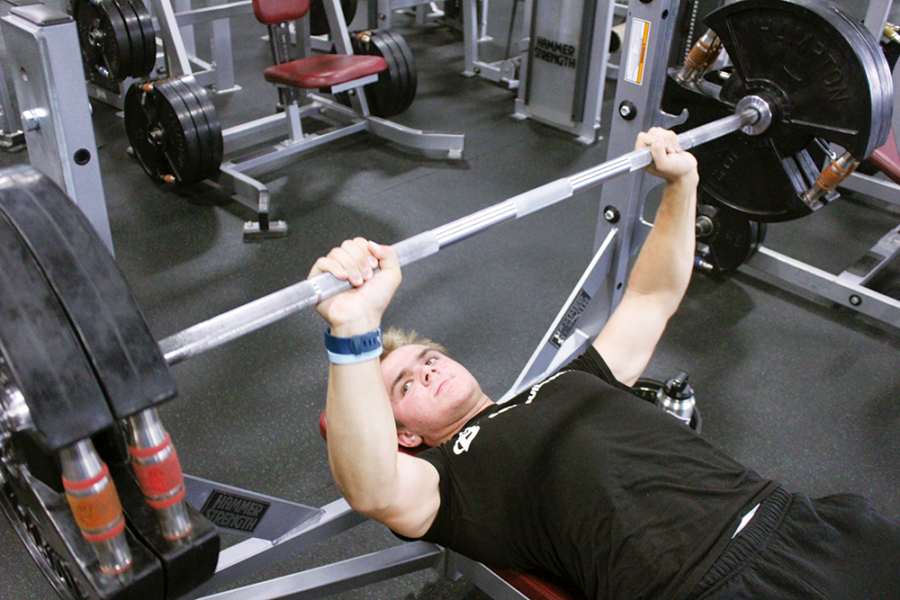On sept. 8, weightlifter and senior Bryce Forsnow second in the National Physique Committee Hoosier Flex Championships, a culmination of his extensive bodybuilding efforts. These efforts included going to LA Fitness seven days a week for six years in order to lift weights and maintain his physique. Along the way, Fosnow said, he had to implement major changes to his lifestyle and diet in order to accomodate weightlifting into his daily routine.
According to Fosnow, he started going to the gym in seventh grade because he struggled with a weight problem.
Fosnow said, “I didn’t like the way I looked so I started to work out, and soon enough, I just fell in love with the sport and art of bodybuilding.”

Strength Training:
Body builder and senior Conner Knipp focuses on lifting weights. Knipp was wearing a waist band to help him maintain his form and balance while lifting so much weight.
Weightlifter and senior Conner Knipp said he also faced a similar situation when he started to lift weights regularly. Knipp said due to his body figure, he wanted to have healthier habits, so he began to go to the gym six days a week starting in his sophomore year. However, when he started, Knipp said it was easy to become discouraged.
Knipp said, “In the beginning, you don’t really see any progress on your body so it’s easy to think that maybe you aren’t doing it properly. But after a while, about a month or so, you can start to see the hard work paying off, and it motivates you to keep on striving to get better and stronger.”
Fosnow said he agrees with Knipp that weightlifting is especially difficult for newcomers who expect next-day results. Fosnow said he wanted to quit when he didn’t see any results, but kept on going to improve his body and develop his passion for bodybuilding.

In addition, Fosnow said it is critical beginners understand the techniques and correct processes behind weightlifting before they start. Athletic trainer Brittani Moore said she sees the most injuries for weightlifters when they have improper technique.
Moore said, “Weightlifters can get strains just like anyone else, especially when they lift too much too soon, which puts a lot of stress on their muscles. They typically have more back problems compared to other athletes because most of them have wrong lifting mechanics.”
Along with proper mechanics, Moore said it is necessary for weightlifters to implement a strict routine that outlines when to work different body parts and when to eat meals.
Knipp said he assigns specific days to specific areas of the body; for example, he works on his back and shoulders every Monday.
Knipp said, “Having a strict routine really helps me make sure I’m not overworking a specific region of my body since everything is organized. At first, I would go to the gym and try to work on everything at once, which led to injuries, but, after I created a routine, I have become more efficient with the way I lift.”

As for diet, Fosnow said it was the hardest part of his lifestyle to change. Now after a few years, his new diet seems almost natural to him. Due to the amount of energy required to lift weights, Fosnow eats over 4,000 calories, 280 grams of protein and a variety of fruits, vegetables and dairy products every day.
Fosnow said, “I buy all of my food and cook it myself because of how expensive it is and how long it takes to prepare. One of my more standard breakfasts is six eggs, toast, a protein shake and a banana. For lunch, I typically have either a chicken breast or ground beef; for dinner, I have some fish along with another protein shake. Then combined with all of that, I constantly take supplements to enhance my daily intake.”

Apc Work Ethic :
CHS soccer player and senior Kate Donovan prepareas to power clean 65 pounds in APC. Donovan has been a varsity soccer player since she was a freshman. “APC helps me strengthen my arms and leg.” Donovan said.
Although it may seem excessive, Moore said such a diet is common for adolescent weightlifters as they are constantly in the gym, meaning they need a high calorie intake to match their expenditures and build muscle. Moore also said while the school lunch at CHS is healthier compared to other schools, it is normal for athletes like Fosnow and Knipp to cook their own lunches and bring extra snacks and shakes so they can meet the higher calorie requirements.
“A lot of people think bodybuilding is mainly just taking steroids and going to the gym all day to lift weights and work out, but that’s a common misconception,” Fosnow said. “It’s really more a sport that is filled with history and ancient statues and competitors. When I look at bodybuilding, I see an art filled with passion and dedication that takes years to master. There’s so much that goes behind just presenting your body at a competition and I find that very unique.”

































![AI in films like "The Brutalist" is convenient, but shouldn’t take priority [opinion]](https://hilite.org/wp-content/uploads/2025/02/catherine-cover-1200x471.jpg)









































![Review: “The Immortal Soul Salvage Yard:” A criminally underrated poetry collection [MUSE]](https://hilite.org/wp-content/uploads/2025/03/71cju6TvqmL._AC_UF10001000_QL80_.jpg)
![Review: "Dog Man" is Unapologetically Chaotic [MUSE]](https://hilite.org/wp-content/uploads/2025/03/dogman-1200x700.jpg)
![Review: "Ne Zha 2": The WeChat family reunion I didn’t know I needed [MUSE]](https://hilite.org/wp-content/uploads/2025/03/unnamed-4.png)
![Review in Print: Maripaz Villar brings a delightfully unique style to the world of WEBTOON [MUSE]](https://hilite.org/wp-content/uploads/2023/12/maripazcover-1200x960.jpg)
![Review: “The Sword of Kaigen” is a masterpiece [MUSE]](https://hilite.org/wp-content/uploads/2023/11/Screenshot-2023-11-26-201051.png)
![Review: Gateron Oil Kings, great linear switches, okay price [MUSE]](https://hilite.org/wp-content/uploads/2023/11/Screenshot-2023-11-26-200553.png)
![Review: “A Haunting in Venice” is a significant improvement from other Agatha Christie adaptations [MUSE]](https://hilite.org/wp-content/uploads/2023/11/e7ee2938a6d422669771bce6d8088521.jpg)
![Review: A Thanksgiving story from elementary school, still just as interesting [MUSE]](https://hilite.org/wp-content/uploads/2023/11/Screenshot-2023-11-26-195514-987x1200.png)
![Review: "When I Fly Towards You", cute, uplifting youth drama [MUSE]](https://hilite.org/wp-content/uploads/2023/09/When-I-Fly-Towards-You-Chinese-drama.png)
![Postcards from Muse: Hawaii Travel Diary [MUSE]](https://hilite.org/wp-content/uploads/2023/09/My-project-1-1200x1200.jpg)
![Review: "Ladybug & Cat Noir: The Movie," departure from original show [MUSE]](https://hilite.org/wp-content/uploads/2023/09/Ladybug__Cat_Noir_-_The_Movie_poster.jpg)
![Review in Print: "Hidden Love" is the cute, uplifting drama everyone needs [MUSE]](https://hilite.org/wp-content/uploads/2023/09/hiddenlovecover-e1693597208225-1030x1200.png)
![Review in Print: "Heartstopper" is the heartwarming queer romance we all need [MUSE]](https://hilite.org/wp-content/uploads/2023/08/museheartstoppercover-1200x654.png)




